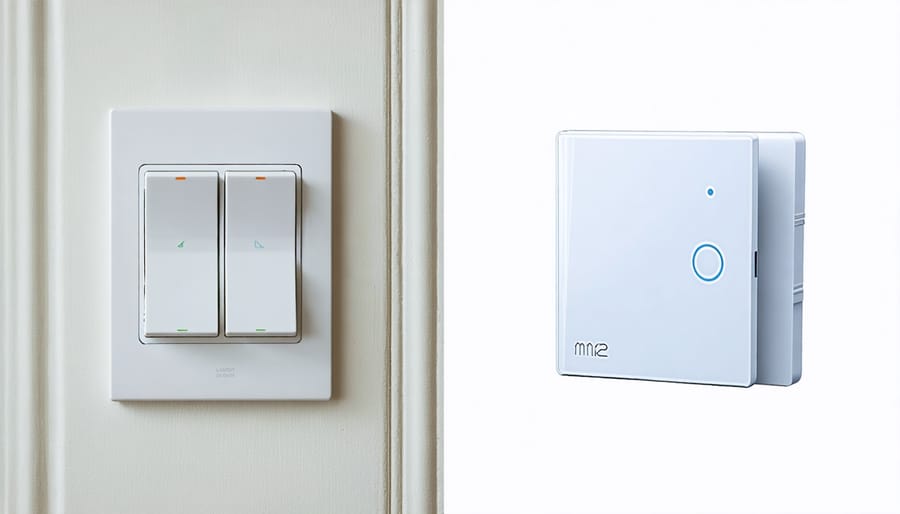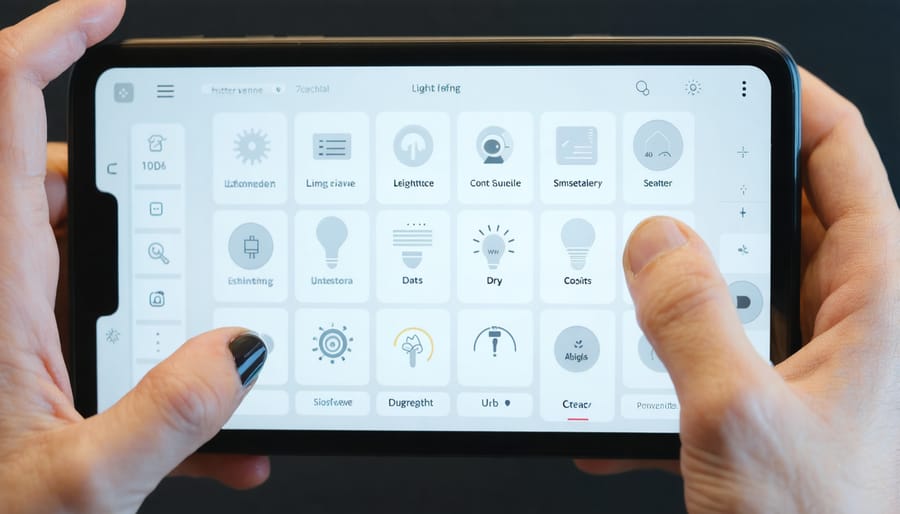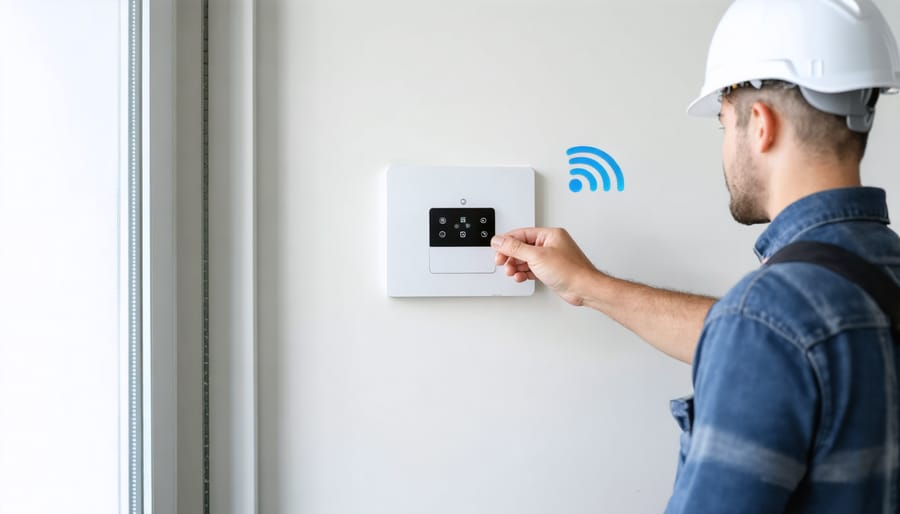Transform your living spaces instantly with modern lighting control systems that let you transform your home’s atmosphere at the touch of a button. From mood-setting dimmer scenes to energy-saving automated schedules, today’s smart lighting solutions offer unprecedented control over your home’s ambiance and functionality.
Gone are the days of simple on-off switches. Modern lighting control systems integrate seamlessly with your smartphone, voice assistants, and home automation hubs, giving you the power to adjust brightness, color temperature, and timing from anywhere. Whether you’re creating the perfect movie night setting, enhancing your home’s security, or reducing your energy bills, these innovative systems adapt to your lifestyle while adding value to your property.
Picture walking into a home that automatically brightens to welcome you, dims gradually as bedtime approaches, and maintains perfect lighting levels throughout the day. That’s the reality of smart lighting control – a blend of convenience, comfort, and cutting-edge technology that’s more accessible and user-friendly than ever before.
Understanding Modern Lighting Control Systems
Wireless vs. Wired Systems
When it comes to lighting control systems, you’ll need to choose between wireless and wired options. Each has its own set of advantages that might work better for your specific situation.
Wireless systems offer fantastic flexibility and easier installation, making them perfect for existing homes. You won’t need to tear up walls or run new cables, and you can start small and expand your system over time. Most wireless systems work through radio frequency or Wi-Fi technology, allowing you to control your lights through a smartphone app or remote control.
On the flip side, wired systems typically provide more reliable performance and faster response times. While they require more extensive installation work – usually during construction or major renovations – they’re generally more stable and less prone to interference. They’re especially suited for new construction or full home renovations where running cables isn’t an issue.
When choosing between the two, consider your home’s age, your renovation budget, and your long-term lighting goals. For most homeowners updating an existing space, wireless systems offer the best balance of features and convenience, while new builds might benefit more from a wired solution.
Key Components and Features
Modern lighting control systems are built around several key components that work together seamlessly to create the perfect ambiance in your home. At the heart of these systems are smart dimmers, which let you adjust light levels smoothly from 0-100% to match any mood or activity. Motion and occupancy sensors automatically manage your lights based on room activity, helping you save energy without lifting a finger.
The system’s brain is the central controller or hub, which coordinates all your lighting devices and can be operated through user-friendly apps on your smartphone or tablet. Photocells and daylight sensors adjust indoor lighting based on natural light levels, while timers and schedulers ensure your lights turn on and off at preset times.
For hands-free control, most systems now include voice control capabilities through popular smart assistants. Scene controllers are another fantastic feature, letting you save and recall your favorite lighting combinations with a single touch. Wall-mounted keypads provide convenient access to these scenes and other lighting controls throughout your home.
Don’t forget about the wireless transmitters and receivers that enable communication between all these components, making installation much simpler than traditional hardwired systems.

Smart Integration and Automation
Voice Control and Mobile Apps
Modern lighting control systems have revolutionized how we interact with our home’s illumination, making it easier than ever to create a cozy atmosphere with just a few taps or voice commands. With smartphone apps becoming increasingly sophisticated, you can now control your entire home’s lighting from anywhere in the world.
Popular voice assistants like Amazon Alexa, Google Assistant, and Apple’s Siri seamlessly integrate with most smart lighting systems. Simply say “Turn off the living room lights” or “Dim the bedroom to 50%” and watch as your home responds instantly. These voice commands work through smart speakers or directly through your phone, making the experience incredibly convenient.
Mobile apps offer even more precise control. You can create custom scenes, schedule lighting changes throughout the day, and even sync your lights with music or movies. Most manufacturers provide user-friendly apps that let you group lights by room, adjust color temperatures, and save your favorite settings for quick access.
The real magic happens when you combine voice and app controls. For instance, you might use voice commands for quick adjustments while relaxing, then switch to the app when you want to fine-tune a lighting scene for your next dinner party. Many systems also offer widgets and shortcuts for your phone’s home screen, providing instant access to your most-used lighting controls.

Setting Up Automated Schedules
Setting up automated schedules for your lighting control system is like having a personal lighting assistant that knows exactly when and how to illuminate your home. Start by identifying your daily routines and lighting needs throughout different times of the day. Most modern systems offer user-friendly apps where you can create multiple schedules with just a few taps.
Begin with the basics: set your lights to gradually brighten in the morning as you wake up, and slowly dim in the evening as bedtime approaches. For security, program outdoor lights to activate at sunset and deactivate at sunrise, incorporating smart outdoor lighting design principles that keep your home safe and welcoming.
Consider creating different scenes for various occasions. A “Movie Night” scene might dim the living room lights to 20% while keeping kitchen path lights at 50%. A “Dinner Party” scene could set dining room lights to full brightness while creating ambient lighting in adjacent areas.
Pro tip: Don’t forget to adjust your schedules seasonally. Winter months might require earlier activation times, while summer schedules can take advantage of natural daylight longer. Most systems also offer vacation modes, which can randomize your lighting patterns to make your home appear occupied while you’re away.
Remember to review and fine-tune your schedules after a few weeks of use. Your initial settings might need adjustment as you discover what works best for your lifestyle.
Practical Benefits and Applications
Energy Efficiency and Cost Savings
One of the most compelling reasons to install a lighting control system is its remarkable impact on energy efficiency and cost savings. These smart systems can significantly reduce your electricity bills by automatically managing light usage throughout your home. By incorporating motion sensors and scheduling features, lights automatically turn off in unoccupied rooms, preventing unnecessary energy waste.
Studies show that implementing smart lighting controls can reduce lighting energy consumption by 50-75%. This translates to substantial savings on your monthly utility bills. For example, dimming features alone can extend bulb life while reducing energy usage – every 10% reduction in lighting power can result in a corresponding 10% decrease in energy consumption.
As part of broader eco-friendly smart home solutions, lighting control systems offer impressive ROI through various features like daylight harvesting, which automatically adjusts artificial lighting based on available natural light. Many systems also provide detailed energy usage reports, helping you identify patterns and optimize settings for maximum efficiency.
The initial investment in a lighting control system typically pays for itself within 2-3 years through reduced energy costs and lower maintenance expenses. Plus, many utility companies offer rebates and incentives for installing energy-efficient lighting solutions, making the transition even more financially attractive.
Enhanced Home Security
A well-designed lighting control system can significantly enhance your home’s security, giving you peace of mind whether you’re asleep upstairs or away on vacation. By programming your lights to mimic your daily routines, you create the impression that someone is always home, deterring potential intruders.
Smart scheduling allows your lights to turn on and off at varying times, creating natural patterns that avoid the predictability of basic timers. You can even integrate motion sensors with your outdoor lighting to automatically illuminate dark areas when movement is detected, startling unwanted visitors and alerting you to potential security concerns.
Many modern lighting control systems offer remote access through smartphone apps, enabling you to adjust your home’s lighting from anywhere. Notice you forgot to turn on the porch light? Simply tap your phone to illuminate the entrance. Receive a security alert? Instantly flood your property with light while checking your security cameras.
These systems can also work alongside other smart home security features, such as cameras and alarm systems, creating a comprehensive security network. Some advanced systems even include “vacation modes” that learn and replicate your typical lighting patterns while you’re away, maintaining a lived-in appearance that keeps your home secure.
Installation and Setup Tips

DIY vs. Professional Installation
When it comes to installing lighting control systems, you’ll need to weigh your DIY skills against the complexity of your desired setup. Simple wireless systems, like plug-and-play smart bulbs or basic dimmer switches, are typically suitable for DIY installation. If you’re comfortable with basic electrical work and can follow detailed instructions, you can tackle these projects during a weekend.
However, more complex systems that require new wiring, multiple zones, or integration with other smart home features usually warrant professional installation. This is especially true for whole-home systems that need careful planning and expertise to ensure proper functionality and safety.
Consider hiring a professional if:
– Your project requires new wiring or electrical panel modifications
– You’re installing a hardwired system
– You want to integrate multiple systems or create complex scenes
– You’re not confident working with electrical components
– Local building codes require licensed electrician work
On the DIY side, you can handle:
– Wireless smart bulb installation
– Plug-in smart switches and dimmers
– Battery-operated motion sensors
– Basic smart home hub setup
– Simple app configuration
Remember, while DIY installation can save money upfront, mistakes can be costly and potentially dangerous. When in doubt, it’s better to invest in professional installation to ensure your system works correctly and safely from day one. Many manufacturers offer certified installers who are familiar with their specific products and can guarantee their work.
Common Setup Challenges
Setting up a lighting control system can sometimes feel challenging, but don’t worry – most common issues have simple solutions. Let’s tackle the frequent hurdles you might encounter and how to overcome them.
One of the most common challenges is wireless interference. If your lights aren’t responding consistently, try moving your hub away from other electronic devices, especially WiFi routers and cordless phones. Sometimes, just a few feet of separation can make a significant difference.
Connectivity problems often stem from devices being too far apart. If some lights aren’t responding, consider adding a signal repeater to extend your system’s range. For larger homes, you might need multiple repeaters strategically placed throughout your space.
Dim or flickering LED lights usually indicate compatibility issues. Ensure you’re using dimmable LED bulbs specifically designed for smart systems. When in doubt, check your system’s compatibility list before purchasing new bulbs.
App connection troubles? Start with the basics: ensure your smartphone is connected to the right network and your system’s hub is properly powered. A quick router restart often resolves these issues.
During initial setup, some users struggle with device pairing. The fix is usually simple: reset the device to factory settings and try again, making sure you’re following the sequence exactly as specified in the manual.
Remember, most manufacturers offer excellent customer support and troubleshooting guides. Don’t hesitate to reach out if you’re stuck – they’ve likely helped others with the same issue before.
Lighting control systems represent a significant step forward in creating a more comfortable, efficient, and modern living space. Whether you’re looking to save energy, enhance your home’s ambiance, or simply make your daily routines more convenient, these systems offer solutions for every need and budget. From basic dimmer switches to comprehensive smart home integration, the options available today make it easier than ever to transform your home’s lighting.
Remember that you don’t need to implement everything at once. Start with a single room or specific lighting need, and expand your system as you become more comfortable with the technology. Consider your lifestyle, budget, and technical comfort level when choosing a solution, and don’t hesitate to consult with professionals for more complex installations.
By taking action now to upgrade your lighting controls, you’ll not only enhance your living space but also potentially increase your home’s value while reducing your energy costs. The perfect lighting system is waiting for you – it’s time to take that first step toward a brighter, more efficient home.
